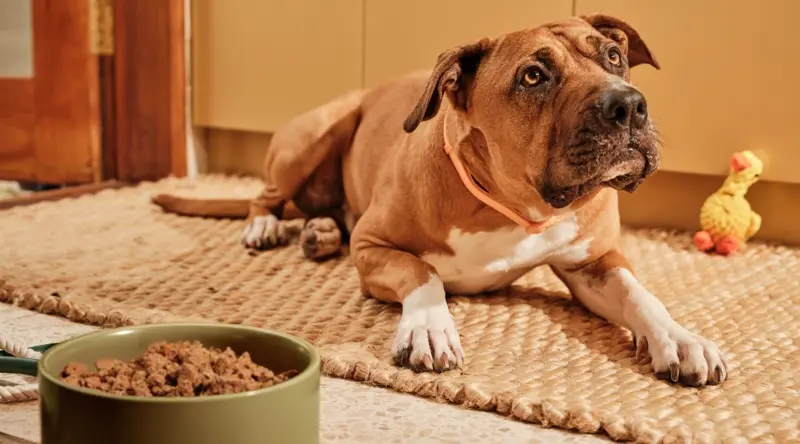Known for their towering frames and tender hearts, Great Danes have truly earned their nickname: the gentle giants. Despite their size, they’re often calm, affectionate, and deeply loyal — a winning combo for families with children or other pets. It’s this gentle nature, wrapped in a very large body, that makes them so beloved.
But with all that size comes responsibility. Training a Great Dane isn’t just helpful – it’s essential. In this guide, we’ll walk through how to train your Great Dane, from understanding their unique temperament to the surprising role real food can play in helping them focus and learn.
Read more: Great Dane breed insights: care, temperament, & expert tips
Great Dane temperament and trainability
At their core, Great Danes are big softies. They thrive on connection and tend to be sociable, affectionate, and keen to be near their humans. Their intelligence and willingness to please make them responsive to training — especially when it starts early and is led with patience.
But don’t be fooled by their mellow nature. That same chill vibe can sometimes look like stubbornness or a lack of motivation. In reality, they’re just sensitive souls who need calm, consistent guidance and reward-based training that builds trust.
Early socialisation is non-negotiable — it lays the groundwork for polite behaviour as they grow into their full-sized selves. And while they might take a little longer to pick up a new command, they respond best to low-stress, positive sessions that let them learn at their own pace.
)
Health considerations that can affect training
Great Danes are prone to several health conditions that can impact training:
Joint issues: Due to their large size, Great Danes are susceptible to issues like hip dysplasia, a condition where the ball and socket of a dog’s hip joint haven’t developed properly. Instead of moving smoothly, the joint grinds and rubs, leading to inflammation, pain, and reduced mobility. Over time, this can result in arthritis or more severe joint damage.
Joint discomfort often shows subtly at first, like slower movement or hesitation during training — before becoming a more serious barrier to exercise and focus.
Try this:
Include dietary ingredients with anti-inflammatory properties, like turmeric, ginger, and omega-3 fatty acids from fish oil (found in all Lyka meals) or green-lipped mussels to help support joint health. Avoid intense physical demands during training and stick to gentle, joint-friendly exercises.
Read more: Hip dysplasia: how can your dog's diet help?
Bloat (gastric torsion): Bloat is a serious and life-threatening condition where the stomach fills with gas and can twist. It's fairly common in large breeds, including Great Danes.
Try this:
Avoid vigorous activity before or after meals or drinking, and space out training from feeding times. Feed your Dane two to three smaller meals daily, made with gently cooked, low-carbohydrate, real ingredients that are easy to digest. A slow feeder can also be a great way to support healthy digestion and help prevent bloat.
Heart conditions: Dilated Cardiomyopathy (DCM) is a common cardiac condition in large breed dogs (like Great Danes) that can lead to congestive heart failure. Heart problems aren't always noticeable, and they're usually identified during routine health checks by a vet.
Dogs with heart conditions are usually advised to eat a low-sodium diet, as too much salt increases their blood pressure and puts their heart under more stress. Heart issues can affect their stamina and energy levels, impacting their training and their overall health and wellbeing.
Try this:
Support your dog’s heart health by feeding them a fresh, real food diet that contains ingredients known for their cardiovascular benefits, like potassium-rich broccoli and mushrooms containing antioxidant properties.
Read more: How diet affects the heart health of dogs
If your Great Dane seems unusually lethargic, distracted, or unmotivated during training, consult your vet to rule out any underlying issues.
How real fuels your Great Dane’s focus
Just like us, dogs learn best when they’re feeling healthy, balanced and energised. Diet plays a big role in your pup’s ability to focus, stay calm, and retain information.
Great Danes benefit from:
Steady energy sources like butternut squash and purple sweet potato, which have a low glycaemic load and help release energy slowly.
Essential fatty acids like DHA and EPA (omega-3s from fish, mussels, or fish oil) support brain health and development, memory, and learning.
Fresh, bioactive nutrients like blueberries and shiitake mushrooms to support immunity, skin health, and overall wellbeing.
“A fresh food diet packed with brain-boosting nutrients supports your dog’s ability to learn and adapt. Omega-3s, especially DHA, are critical for memory and cognitive function.”
– Dr Alex England, Lyka Veterinarian, BVetMed MANZCVS (Small Animal Veterinary Practice)
Learn more about Dr Alexander England and his veterinary experience.
All Lyka meals are formulated by Board-Certified Veterinary Nutritionists to provide complete and balanced nutrition for learning, growth, and everyday health.
Read more: What does a Great Dane eat? Breed-specific nutrition tips
Read more: Fuelling your dog’s focus: how nutrition impacts your dog’s training
Exercise first for improved focus
Exercising your Great Dane before a training session can help burn off excess energy and improve concentration. While they aren’t as hyperactive as some breeds, they still require daily exercise to stay healthy and engaged.
Ideal activities include:
Long, moderate-paced walks
Light playtime in the yard
Gentle hiking or nature walks (depending on their age and joint health)
Avoid strenuous exercise that could stress their joints, especially in growing puppies or seniors.
)
Training tips for Great Danes
Training a Great Dane is about building trust and structure from an early age. Their size alone makes good manners essential.
Keep sessions short, sweet, and full of positive vibes. Here’s what works best:
Positive reinforcement
This is the gold standard for training. Marking good behaviour with rewards like praise, affection, treats, or continued interaction teaches your pup how to behave and supports a strong and positive relationship.
Double up on rewards to mark excellent responses from your Great Dane, like praise and a pat, or praise and a treat.
Find their favourite motivator
Discovering your pup’s hierarchy of high-value rewards is a great way to keep your Great Dane motivated. Is it a nibble of roast chicken, their favourite squeaky toy, or playtime with you?
Train at the right time
Sometimes dogs don’t have the energy or desire to learn, especially if they’re too tired, too full, or hot and bothered.
Mental enrichment through training can be tiring for dogs, so find the right time to train and stop if you notice your dog starting to lose focus or fatigue.
Stay consistent
Consistency is key to training. Not just in setting your expectations, but in using the same verbal and non-verbal cues.
Be playful and engaging
Dogs are sensitive souls that can pick up on your mood. Keep your sessions fun and your positive energy will be contagious.
Watch their body language
If your pup starts to show signs of stress or tiredness, give them a break. If they’ve reached saturation point, it can be counterproductive to persevere. You can always come back to the training at another time.
Training your Great Dane puppy
Great Dane puppies are wonderfully sweet and surprisingly calm — but don’t let that fool you. Their size increases rapidly, so early training and socialisation are vital.
What works?
A regular toilet routine
Positive crate training for safe sleep and downtime
Early and controlled socialisation with people, dogs, sounds, places and situations
Great Danes are sensitive to harsh corrections, so always use gentle, force-free methods that promote trust and confidence.
)
Training your adult Great Dane
Just because your Great Dane’s out of puppyhood doesn’t mean the training stops. In fact, ongoing mental stimulation is essential to keep their mind sharp and behaviour balanced.
This might look like:
Reinforcing polite greetings at the door
Learning new tricks or games
Adjusting to life changes, like moving house
Training for mobility support, like using a ramp in senior years
Dogs have neuroplasticity, meaning they’re capable of learning at any age. Keep training light and engaging, and always celebrate progress — no matter how small.
When to call in a trainer or behaviourist
Not sure if your Great Dane’s quirks are just stubbornness — or something deeper?
A trainer is your go-to for obedience, manners, and routine behaviours. A qualified behaviourist, on the other hand, is best for issues like:
Reactivity
Anxiety or phobias
Aggression
Resource guarding
They work closely with your vet to address underlying causes and create a tailored plan. The earlier you seek support, the easier it is to create lasting change.
“If training your dog is very challenging, it may be worth considering a trainer or a behaviourist. A trainer can help you identify what may be triggering their behaviour and show you how to help your dog cope in those situations. The solution may be as simple as reframing what we expect from our dogs and our behaviours around them.”
— Laura V, qualified dog behaviourist
New to Lyka? Let’s Rethink Dog Food Together
Training your Great Dane is a journey — one that requires consistency, creativity, and compassion. Whether you’re navigating house training with a stubborn puppy or teaching your senior dog new routines, every small win is a step toward a calmer, more connected life together.
And remember, a well-fed brain is a trainable brain. Supporting your Great Dane’s learning with fresh, real food meals helps unlock their full potential.
Lyka nourishes hundreds of Great Danes across Australia – from energetic pups to seniors in their golden years – they’re all thriving on Lyka.
)
)
)

)
)
)
)
